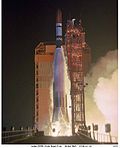Vela (satellite)
The Vela satellites (from Spanish velar or after the constellation sails of the ship ) were a series of American surveillance satellites that were intended as part of the Vela project to carry out above-ground atomic bomb tests from space using the gamma radiation they emit from all over the earth . They were an instrument for effective verification of compliance with the Treaty on the Prohibition of Nuclear Weapons Tests in the Atmosphere, in Space and Underwater of 1963 (Partial Test Ban Treaty, PTBT) between the USA , the USSR and Great Britain . They brought new impulses to gamma astronomy by discovering the gamma-ray bursts from the depths of space.
Vela series
The Vela satellites all had the shape of an icosahedron and were twist stabilized . All had X-ray , neutron , and gamma-ray detectors on board as primary instrumentation . They were placed in orbits from 101,000 to 113,000 km altitude.
Initially, six satellites were put into orbit by Atlas-Agena rockets , each in service for five years: Vela 1 and 2 on October 17, 1963, Vela 3 and 4 on July 17, 1964, Vela 5 and 6 on July 20, 1965. These satellites only registered gamma radiation from space, not from the earth's atmosphere . Since this series was very successful, a series of improved Vela satellites with rockets of the type Titan-IIIC were also brought into orbit in pairs, which in addition to some scientific instruments also equipped with instruments for the optical detection of atomic bomb explosions in the atmosphere and each for more than 10 years were in operation: Vela 7 and 8 on April 28, 1967, Vela 9 and 10 on May 23, 1969, Vela 11 and 12 on April 8, 1970. The last three Vela satellites were switched off in 1985.
More generally, however, the names of the Vela satellites are named after the pairs sent into space at the same time, i.e. Vela 1A and 1B for Vela 1 and 2 to Vela 6A and 6B for the last.
The tasks of Vela were taken over by the GPS satellites as part of the US Nuclear Detection System (NDS) program.
Measuring principle
The two satellites of a pair each monitored almost the entire earth. This was possible because the satellites of a pair flew one behind the other in the same orbit (from approx. 107,000 km altitude with 38 ° inclination ) offset by 180 ° to each other. (Example: If satellite A flew over zero longitude, satellite B was also over 180th longitude.) If an atom bomb exploded, only one of the two satellites could record the explosion . Because a satellite of another pair - which orbits the earth perhaps only 60 ° to the satellites of the first pair - also registers the explosion, the difference in time between the arrival of the explosion flash at the two satellites could be used to determine where the Explosion was coming.
If both satellites in a pair registered a gamma-ray burst with a time difference corresponding to the diameter of their orbit (over 210,000 km), it could not have originated from Earth.
Results
Military surveillance
Their main purpose, the verification by the signatory states of the stop of surface nuclear weapons tests (which led to a significant increase in background radioactivity on the whole earth), was fulfilled by these satellites with success. The signatories of the agreement actually adhered to it, although the non-signatory countries France and the People's Republic of China carried out above-ground tests for a long time (last above-ground test on October 16, 1980 by China). Only one incident of the atomic bomb explosions registered by the Vela satellites is still controversial: The so-called Vela incident on September 22, 1979 in the South Atlantic off South Africa , in which one of the now no longer fully functional satellites registered signals corresponding to a small atomic bomb explosion could. To date, it is unclear whether such a test ever took place, as there were no significant signs of an above-ground nuclear test in the suspected region despite intensive investigations and the suspected perpetrators South Africa and Israel did not officially admit this or have so far not clearly refuted it.
Mysterious gamma-ray bursts
In addition to their main military function, the Vela satellites discovered numerous unknown short gamma- ray events, so-called gamma ray bursts, which were long considered inexplicable. However, it was found out in 1973 that these did not come from the earth, but from the depths of space. The Vela satellites were thus an important step in the development of gamma astronomy. A large part of the output of the Vela satellites was therefore quite unexpectedly not military surveillance, but space exploration. However, the scientific results were only released for research after a few years.
Web links
- Technical Overview Vela first series (English)
- Technical overview extended Vela series (English)
- Summary of the Vela missions (English)
- Detailed report on the incident from 22 September 1979 (English)
- Director of Central Intelligence: The September 22, 1979 Event . at www.gwu.edu (George Washington University) (English; PDF; 1.3 MB)
- Vela 5B in a NASA Goddard Space Flight Center database
- Vela 6A and 6B in a database at NASA Goddard Space Flight Center





